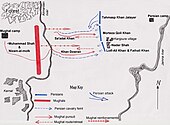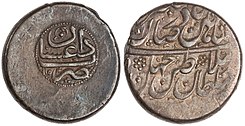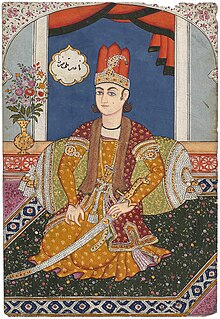Nader Shah
Nader rose to power during a period of chaos in Iran after a rebellion by the Hotaki Afghans had overthrown the weak Shah Soltan Hoseyn (r. 1694–1722), while the arch-enemy of the Safavids, the Ottomans, as well as the Russians had seized Iranian territory for themselves.His numerous campaigns created a great empire that, at its maximum extent, briefly encompassed what is now part of or includes Afghanistan, Armenia, Azerbaijan, Bahrain, Georgia, India, Iran, Iraq, Turkey, Turkmenistan, Oman, Pakistan, Uzbekistan, the North Caucasus, and the Persian Gulf, but his military spending had a ruinous effect on the Iranian economy.At its peak, under such figures as Abbas the Great, Safavid Iran had been a powerful empire, but by the early 18th century the state was in serious decline and the reigning shah, Soltan Hoseyn, was a weak ruler.Under their leader Mahmud Hotaki, the rebellious Afghans moved westwards against the shah himself and in 1722 they defeated a force at the Battle of Gulnabad and then besieged the capital, Isfahan.[27] After the Shah failed to escape or to rally a relief force elsewhere, the city was starved into submission and Soltan Husayn abdicated, handing power to Mahmud.Nader suggested to his closest intimates, after a great hunting party on the Moghan plains (presently split between Azerbaijan and Iran), that he should be proclaimed the new king (shah) in place of the young Abbas III.[39] Nader approved with the proposal, and the writers of the chancellery, which included the court historian Mirza Mehdi Khan Astarabadi, were instructed with sending out orders to the military, clergy and nobility of the nation to summon at the plains.Nader was crowned Shah of Iran on 8 March 1736, a date his astrologers had chosen as being especially favorable,[42] in attendance of an "exceptionally large assembly" composed of the military, religious and nobility of the nation, as well as the Ottoman ambassador Ali Pasha.[43] He cut a deal with notables and the clergy that he would only assume the position of Shah if they promised to refrain from cursing Omar and Uthman, avoid beating themselves to draw blood at the Ashura festival, accept Sunni practices as legitimate, and to obey Nader's children and relatives after his death, thereby setting up a dynasty in his name.[48] Nader hoped that "Ja'farism" would be accepted as a fifth school (madhhab) of Sunni Islam and that the Ottomans would allow its adherents to go on the hajj, or pilgrimage, to Mecca, which was within their territory.The commission was supervised by Mīrzā Moḥammad Mahdī Khan Monšī, the court historiographer and author of the Tarikh-e-Jahangoshay-e-Naderi (History of Nader Shah's Wars).Nader used the pretext of his Afghan enemies taking refuge in India to cross the border and invade the militarily weak but still extremely wealthy far eastern empire,[51] and in a brilliant campaign against the governor of Peshawar he took a small contingent of his forces on a daunting flank march through nearly impassable mountain passes and took the enemy forces positioned at the mouth of the Khyber Pass completely by surprise, utterly beating them despite being outnumbered two-to-one.During the course of one day (22 March) 20,000 to 30,000 Indians were killed by the Iranian troops and as many as 10,000 women and children were taken as slaves, forcing Mohammad Shah to beg Nader for mercy.[citation needed] Still, the remaining plunder his forces had seized from India was so much that Nader was able to stop taxation in Iran for three years following his return.[77] In order to construct a broad political framework that could link him to the Ottomans and Mughals more closely than the Safavids had been, Nader Shah started creating new concepts.He adds that this was part of unpolished drafts of concepts that would get polished throughout the 11 years of Nader Shah's reign, and would include wide political and religious aspects.He may have perceived a need to unite disparate components of the ummah against the expanding power of Europe at that time, however his view of Muslim unity was different from later concepts of it.Nader Shah had not yet had time to get dressed; Muhammad Quli Khan ran in first and struck him with a great blow of his sword which felled him to the ground; two or three others followed suit; the wretched monarch, covered in his own blood, attempted – but was too weak – to get up, and cried out, 'Why do you want to kill me?In 1768, Christian VII of Denmark commissioned Sir William Jones to translate a Persian language biography of Nader Shah written by his Minister Mirza Mehdi Khan Astarabadi into French.[87] Nader's Indian campaign alerted the East India Company to the extreme weakness of the Mughal Empire and the possibility of expanding to fill the power vacuum.[90] The strong character of Nader Shah is indicated by the fact that having achieved much fame and glory, he did not allow his pleasers to find great ancestors in the darkness of his origin.There is a story that says, having demanded the daughter of his defeated enemy Muhammad Shah, the Emperor of Delhi, to marry his son Nasrullah, he received the answer that a royal lineage up to the 7th generation was required for marriage with a princess from the House of Timur."[91] Nader had the greatest contempt for the weak, depraved Muhammad Shah, who, according to the local chronicler of that era, "was always with his mistress in his arms and a glass in his hand," and was the lowest libertine and simply a puppet ruler."[citation needed] French orientalist Louis Bazin describes the personality of Nader Shah as follows: Despite his obscure background, he looked born for the throne.He had small penetrating eyes with a sharp and piercing gaze; his voice was rude and loud, although he knew how to soften it on occasion, as required by personal interest...Nevertheless, the repulsive greed and unprecedented cruelties that wore his subjects, ultimately led to his fall, and the extremes and horrors that were caused by him, made Persia cry.He drinks wine moderately, hours of his rest among ladies are very rare, his food is simple, and if government affairs require his presence, he rejects his meal and satisfies hunger with fried peas (which he always carries in his pocket) and a sip of water...He has such a strong physique that he often sleeps on a frosty night on bare ground in the open air, wrapping himself only in his cloak and putting a saddle under his head as a pillow.[94]Member of the French Academy of Sciences, Pierre Bayen wrote about Nader Shah the following: He was the horror of the Ottoman Empire, the conqueror of India, the ruler of Persia and all of Asia.[96] The Kashmiri historian Lateef described him as follows: "Nader Shah, the horror of Asia, the pride and savior of his country, the restorer of her freedom and conqueror of India, who, having a simple origin, rose to such greatness that monarchs rarely have from birth".









Mohammad Nadir ShahNadir Shah (disambiguation)King of KingsSultan of the Sultans of the WorldBritish LibraryLondonShah of IranCoronationAbbas IIISafavid dynastyAdel ShahDastgerdKhorasanSafavid IranQuchanAfsharid IranTomb of Nader ShahMashhadRazia Begum SafaviReza Qoli MirzaMorteza MirzaJoseph von SemlinDynastyAfsharidTwelver Shia IslamNaderian WarsFall of the SafavidsBattle of GulnabadSiege of IsfahanKhorasan CampaignSanganSabzevar1st Afghan CampaignKafer Qal'ehHerat 17292nd Afghan CampaignQandaharSafavid restorationDamghanKhwar passMurche-KhortIsfahanZarghanFirst Ottoman WarWest Persian CampaignTahmasp's CampaignMesopotamian CampaignSiege of BaghdadSamarraKirkukCaucasus CampaignYeghevārdIndian CampaignKhyber PassBattle of KarnalSack of DelhiSindh ExpeditionBattle of Chenab (1739)Central Asian CampaignDagestan CampaignWithdrawal of AndalalPersian Gulf CampaignSecond Ottoman WarSiege of MosulSiege of KarsBattle of KarsRebellion of Sheikh Ahmad MadaniRebellion of 1733Fars Rebellion of 1744PersianAfsharid dynastyIranian historyshah of Iran (Persia)numerous campaignsMihmandustKarnalNapoleonAlexanderTurkomanAfsharsQizilbashHotakiAfghansSoltan HoseynOttomansRussiansNorth CaucasusPersian GulfGenghis KhanWest AsiaShahrokh ShahAgha Mohammad Khan QajarAfshar tribeTurkestanAzerbaijanMongol EmpireShah Ismail IShah Abbas IAfshar dialectAzerbaijanihigh cultureArabicTurco-MongolMichael AxworthyherdsmanUzbeksTurkmensmusketeerRusso-Persian War (1722–1723)Treaty of Constantinople (1724)Abbas the GreatGhilzai AfghansKandaharGurgin KhanMahmud HotakiTahmasp IIQajar tribePeter the GreatVakhtang VIRusso-Iranian War (1722–1723)South CaucasusDagestanDerbentMazandaranAstrabadGeorgia
